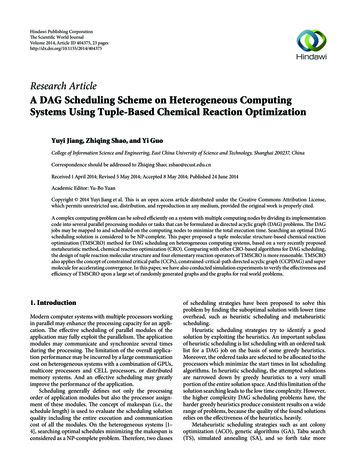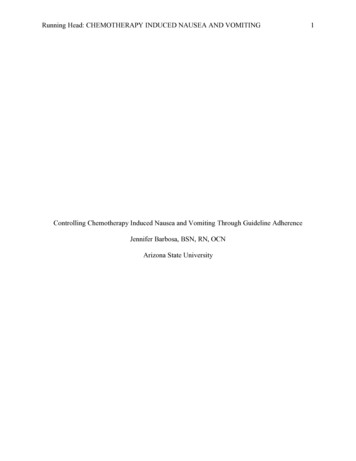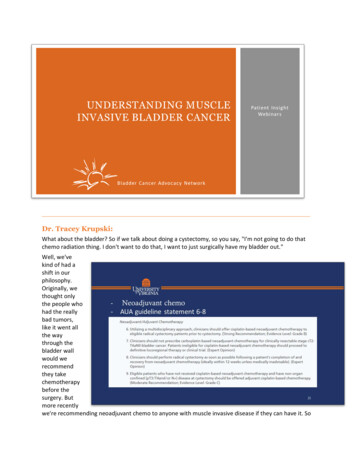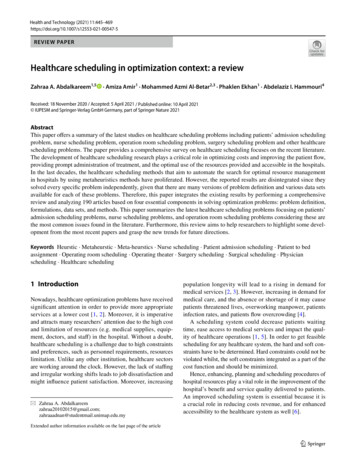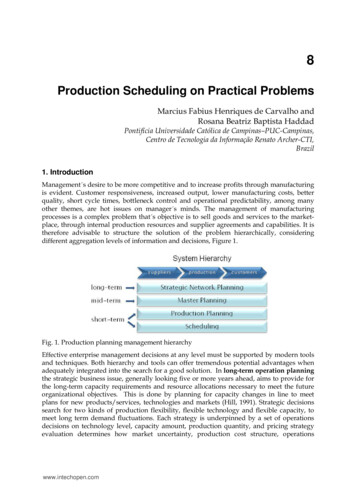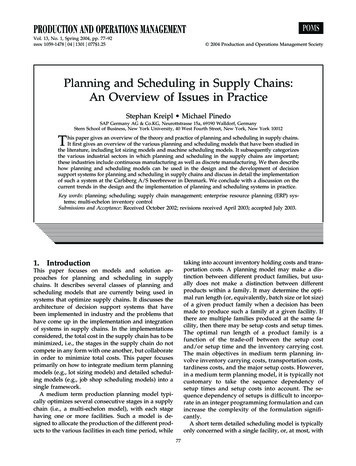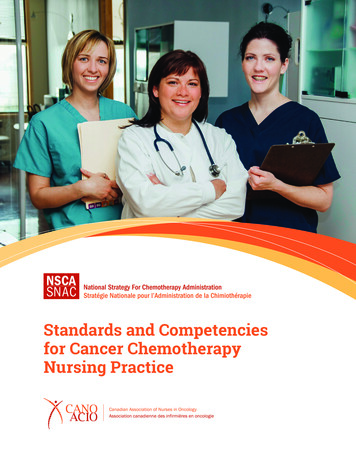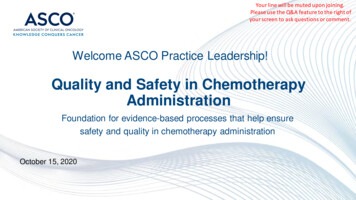
Transcription
Chemotherapy Operations Planning and SchedulingAyten TurkcanPurdue University, Regenstrief Center for Healthcare Engineering, West Lafayette, IN 47907aturkcan@purdue.eduBo ZengUniversity of South Florida, Industrial and Management Systems Engineering, Tampa, FL 33620bzeng@eng.usf.eduMark LawleyPurdue University, Weldon School of Biomedical Engineering, West Lafayette, IN 47907malawley@purdue.eduFebruary 12, 2010Chemotherapy operations planning and scheduling in oncology clinics is a complex problem due to severalfactors such as the cyclic nature of chemotherapy treatment plans, the high variability in resource requirements (treatment time, nurse time, pharmacy time) and the multiple clinic resources involved. Treatmentplans are made by oncologists for each patient according to existing chemotherapy protocols or clinical trials. It is important to strictly adhere to the patient’s optimal treatment plan to achieve the best healthoutcomes. However, it is typically difficult to attain strict adherence for every patient due to side effects ofchemotherapy drugs and limited resources in the clinics. In this study, our aim is to develop operations planning and scheduling methods for chemotherapy patients with the objective of minimizing the deviation fromoptimal treatment plans due to limited availability of clinic resources (beds/chairs, nurses, pharmacists).Mathematical programming models are developed to solve chemotherapy operations planning and scheduling problem. A two-stage rolling horizon approach is used to solve these problems sequentially. Real-sizeproblems are solved to demonstrate the effectiveness of the proposed algorithms in terms of solution qualityand computational times.Key words : Chemotherapy, planning, scheduling, oncology1.IntroductionCancer is the second most common cause of death in the US, accounting for 26% of all deaths [2].The National Cancer Institute estimates that approximately 11.1 million Americans with a historyof cancer were alive in January 2005. Some of these individuals were cancer-free, while others stillhad evidence of cancer and may have been undergoing treatment [2]. In 2009, approximately 1.5million new cancer cases are expected to be diagnosed in the US [2]. The National Institutes ofHealth estimates overall costs of cancer in 2008 at 228.1 billion; 93.2 billion for direct medicalcosts (total of all health expenditures), 18.8 billion for indirect morbidity costs (cost of lostproductivity due to illness), and 116.1 billion for indirect mortality costs (cost of lost productivity1
Turkcan et al.: Chemotherapy Operations Planning and Scheduling2due to premature death) [2].Cancer is defined as a group of diseases characterized by uncontrolled growth and spread ofabnormal cells [2]. Cancer has more than one hundred different types that vary in diagnosticdetectability, state of cellular differentiation, rate of growth, invasiveness, metastatic potential andresponse to treatment [27]. The treatment decision is made according to the stage of the disease,expected survival rate, recurrence risk, and patient’s health condition. A cancer’s stage is based onthe primary tumor size and whether it has spread to other areas of the body. Figure 1.a shows thestages of tumor growth. If cancer cells are present only in the layer of cells where they developedand have not spread, it is called in situ cancer. If cancer cells invade neighboring tissues andspread to other parts of the body through the blood and lymph systems, the tumor is said to beinvasive/malignant.c 1999 BSCS and Videodiscovery(a)Figure 1(b)Tumor growth [6] and cell cycle (adapted from [21, 23])Cancer is treated with different methods such as surgery, radiation, and chemotherapy. Surgeryand radiotherapy are local treatments used to remove/kill small tumors or reduce the size of largetumors. In contrast, chemotherapy is a systemic approach that uses drugs to stop or slow tumorgrowth, control or prevent the spread of cancer cells, and/or relieve cancer symptoms such as pain(palliative chemotherapy). Chemotherapy drugs affect both normal and cancer cells by alteringcellular activity during one or more phases of the cell cycle. The cell cycle includes five phases(G0 , G1 , S, G2 , M ) during which the cell grows, replicates, and rests (see Figure 1.b). G1 is the firstgrowth phase where the cell prepares for DNA synthesis by producing RNA and protein. Synthesisof DNA occurs during the S phase, which is followed by a second period of growth, the G2 phase.During G2 , synthesis of RNA and proteins continues as the cell prepares for division during the M
Turkcan et al.: Chemotherapy Operations Planning and Scheduling3(mitosis) phase. After mitosis, the cell will either enter another cycle or await activation by restingin G0 [4].Chemotherapy drugs include both cell-cycle phase specific and cell-cycle phase non-specificdrugs [4]. Cell-cycle phase specific drugs kill cells in a specific phase of the cell cycle. These typesof drugs do not affect cells in the resting state [14]. They are most effective against cells that arerapidly dividing (especially when tumor size is small). Cell-cycle phase non-specific drugs affectcells in all phases of the cell cycle and are most effective against slow dividing cells (especiallywhen tumor size is large). Chemotherapy treatment is given in cycles and a rest period is givenbetween each cycle so that the number of normal cells increases and the body recovers. Severalcycles of treatment are needed, as chemotherapy kills only a certain percentage of cancer cells [4].The number and duration of the cycles depend on many factors such as cancer type, stage of thedisease, and the general health of the patient. Treatment plans are developed by oncologists foreach patient according to existing chemotherapy protocols or clinical trials.In recent years, demand for chemotherapy has been increasing due to the aging population andmore effective drugs. Warren et al. [30] analyzed the costs associated with surgery, chemotherapy,radiotherapy and hospitalizations for 306,709 persons aged 65 and older and diagnosed with breast,lung, colorectal, or prostate cancer. The proportion of cancer patients treated with chemotherapyincreased from 15% to 21% between 1991 and 2002 [30]. The mean cost of chemotherapy has alsoincreased significantly due to more effective, but more expensive drugs [30]. Mean lung cancerchemotherapy costs were the highest ( 15,000) and increased by 8,173 per person treated between1991 and 2002. Breast cancer chemotherapy costs increased an average of 6,160 over that periodand by 2002 were 12,802 per person (yearly increase in cost 549).Due to increased demand, oncology clinics experience higher workload that results in delays inlaboratory, pharmacy, and chemotherapy administration areas. Waiting time for appointments,laboratory test results, and chemotherapy administration has been identified as a major sourceof patient dissatisfaction (Lis et al. [20]). Gesell et al. [15] analyzed the data from 5,907 cancer outpatients treated at 23 hospitals across the US and identified the top priorities for serviceimprovement in outpatient cancer treatment facilities. The results indicate that reducing waitingtimes for the first visit and waiting times in the clinic for chemotherapy administration are amongthe highest priorities for quality improvement. Many studies indicate that well-designed schedulingcan increase access to care, smooth clinic operations, increase patient satisfaction, improve qualityof care, and reduce overall costs [1, 28]. Gruber et al. [16] studied data from an infusion clinic andfound that appointment schedule that does not reflect the availability of resources is one of the
Turkcan et al.: Chemotherapy Operations Planning and Scheduling4most frequent cause of delay. Chabot and Fox [8] developed a patient classification system thatestimated patient care needs and nursing care time for the volume of patients and diversity oftreatments that occurred in an outpatient chemotherapy unit. The classification system allowedrealistic scheduling of patient appointments. Dobish [13] proposed a next-day chemotherapy schedule, with laboratory and physician appointments on one day and chemotherapy administrationis on the next day. The implementation of this next–day chemotherapy administration scheduleresulted in improved efficiencies for pharmacy and nursing and decreased in-clinic waiting timesfor patients.Most previous studies propose using scheduling templates/rules based on nursing or pharmacytimes (Langhorn and Morrison [18], Diedrich and Plank [12], Hawley and Carter [17]). The scheduling decisions are made in an ad-hoc manner according to physician and scheduler experiences andpatient preferences. To the best of our knowledge, there is no study that proposes optimizationmethods to schedule chemotherapy treatments optimizing several objectives such as minimizationof treatment delay, patient waiting time and staff overtime, and maximization of staff utilization. In this paper, we develop planning and scheduling methods for chemotherapy patients withthe objective of decreasing patient waiting time and maximizing adherence to treatment plans,while considering the limited availability of clinic resources (beds/chairs, nurses, pharmacists). Thisstudy differs from previous studies in that it develops and uses optimization methods rather thanscheduling templates and ad-hoc rules.The paper is structured as follows. Section 2 explains the chemotherapy planning and schedulingproblem in detail. Section 3 presents a mathematical programming model, and section 4 presentsa two-stage algorithm to solve planning and scheduling problems sequentially. Section 5 presentsa variety of computational studies to illustrate the effectiveness of the proposed algorithms, andSection 6 provides some concluding remarks and discusses future work.2.Problem characteristicsChemotherapy planning and scheduling in oncology clinics is a complex problem due to severalfactors such as the cyclic nature of treatment plans, high variability in treatment times, and multipleclinic resources involved. Chemotherapy treatment is given in cycles with rest periods during andbetween each cycle. The number and duration of the cycles change according to cancer type andstage of the disease. It is important to strictly adhere to the patients prescribed treatment planto achieve the best health outcomes. However, it is typically difficult to attain strict adherencedue to clinic/patient scheduling complexities, side effects of the chemotherapy drugs, and limited
Turkcan et al.: Chemotherapy Operations Planning and Scheduling5resources in the clinics. Multiple resources such as pharmacists, phlebotomy staff, chemotherapynurses, chairs, etc. are required for chemotherapy administration. The treatment lengths, nursingand pharmacy times show high variability according to the cancer type, patient condition, andnumber of drugs used. Nurse workflow varies for different treatments according to the numberof drugs, infusion method, and risk of side effects. Nurse workflow may become complicated fortreatment regimens with multiple drugs and high risk of side effects. It is important to consider theavailability of all resources and complex workflow of chemotherapy nurses for safe administrationof chemotherapy.This work develops planning and scheduling methods for chemotherapy patients in oncologyclinics. We define the planning problem as the allocation of patient treatments to days with theobjective of minimizing unnecessary delays due to limited resources and under-utilization and overutilization of resources, and the scheduling problem as the determination of appointment timesfor chemotherapy patients on each day with the objective of minimizing patient staff idle time,and overtime. This problem is more difficult than the classical appointment scheduling problems,which consider a single resource and one type of patient with similar service time requirements.The problem characteristics are explained in detail in the following subsections.2.1.Chemotherapy treatmentChemotherapy treatment plans are developed by oncologists for each patient according to existingchemotherapy protocols and the patient’s condition. Chemotherapy protocols show the types ofdrugs, doses, and schedule of drugs based on the type of cancer, stage of cancer, and other specificsabout the person’s cancer (a comprehensive list of protocols can be found on the National Comprehensive Cancer Network (NCCN) website [22]). Table 1 shows a sample chemotherapy regimen(BEP) with three drugs. CISplatin is administered intravenously (IV) over 30 minutes on Days 1-5.Etoposide is administered intravenously over 60 minutes on Days 1-5. Bleomycin is administeredintravenously over 30 minutes on Days 1, 8, and 15. The administration time is 120 minutes onDay 1 and 90 minutes on Days 2-5, and 30 minutes on Days 8 and 15. Pre-medication might berequired for hypersensitivity before Bleomycin, which adds 30-60 minutes to the administrationtime on Days 1, 8, and 15. No treatment is given on days 6-7, 9-14, and 16-21. The 21-day cycleis repeated 2 to 4 times. It is important to adhere to the patient’s treatment plan to achieve thebest results, since delaying the treatment reduces the dose intensity and hence decreases its effectiveness. Leonard et al. [19] shows that a 7-day delay in chemotherapy delivery reduces the doseintensity by 5%. Many other studies show the correlation between low dose intensity and poorhealth outcomes (i.e. decreased tumor growth control, poorer quality of life, and shortened overallsurvival) [5, 7, 9, 26, 31].
Turkcan et al.: Chemotherapy Operations Planning and Scheduling6Days12-56-789-141516-21Table 12.2.DrugsDoseTreatment22CISplatin, Etoposide, Bleomycin 20 mg/m , 100 mg/m , 30 units IV over 30, 60, 30 minutesCISplatin, Etoposide20 mg/m2 , 100 mg/m2IV over 30, 60 minutesRestBleomycin30 unitsIV over 30 minutesRestBleomycin30 unitsIV over 30 minutesRestA sample chemotherapy regimen [29]Resources in the chemotherapy treatment environmentIn the last two decades, chemotherapy administration has shifted from the inpatient setting tothe outpatient setting due to sophisticated delivery methods, new oral preparations of drugs,and improved management of side-effects, enabling patients to tolerate their treatments withoutbeing hospitalized. The administration of chemotherapy in the outpatient setting has the inherentchallenge of time constraints (Chabot and Fox [8]), that is, outpatient clinics treat patients duringworking hours and patients do not stay overnight.Chemotherapy treatment requires several resources. Table 2 provides the human resources andtheir tasks. Besides clinic staff, chemotherapy treatment requires resources such as chairs, beds andequipment (ports, pumps, IVs, etc.). The availability of resources determines the capacity of theclinic. Actually determining the capacity is a complex issue [3] due to high variability in treatmentlengths, nursing and pharmacy times. For example, in an oncology clinic, the number of chairs andbeds can be used as the maximum capacity and patients can be scheduled based on their treatmenttimes and availability of chairs/beds. However, the number of nurses may not be sufficient to staffall the chairs/beds. Sometimes, the chairs/beds might be fully utilized, but the nurses might be idledue to varying nursing times for each treatment. In this study, we seek to minimize the overtimeand idle time of clinic staff while making planning and scheduling decisions.StaffAdministrative staffPatient service assistantsMedical assistantsPathology staffOncologistsPharmacy staffPortering staffChemotherapy nursesTable 2TasksManage the clinicRegister the patientPrepare patient documentation and provide supportive carePerform lab testsSee patients to evaluate patients’ health and make treatment decisionsPrepare chemotherapy regimensTransport specimens, chemotherapy drugsAdminister chemotherapy to patientsOncology clinic staff and their tasks
Turkcan et al.: Chemotherapy Operations Planning and Scheduling7The flow of chemotherapy patients in an oncology clinic is shown in Figure 2. All patients arriveto the clinic by appointment. The patient service assistant (PSA) registers the patient. The medical assistant (MA) prepares patient charts and takes vitals. The phlebotomy staff draws blood forlaboratory tests. If the patient has a port (device inserted under the skin of the patient by surgical procedure to facilitate the blood drawing process), these tasks are performed by a nurse. Thepatient waits in the waiting room until the laboratory results become available. Sometimes, thepatient has his/her blood drawn and analyzed in another clinic prior to the infusion appointment.In that case, there will be no phlebotomy work in the oncology clinic. The oncologist checks laboratory results and sees the patient. If the patient’s health is suitable for the treatment, she/he issent to the infusion clinic for a same-day treatment or an appointment is scheduled for chemotherapy administration at a later date. If the patient has not totally recovered, the oncologist maydelay the treatment until the patient becomes ready for the treatment. When the patient comes tothe infusion clinic, he/she waits for an available chair/bed and nurse. When these become available, the chemotherapy nurse takes the patient to the chair/bed. The pharmacy staff preparesthe chemotherapy drugs. The portering staff transports the drugs from pharmacy to the clinic.Chemotherapy nurses administer the chemotherapy to the patient.RegistrationFigure 22.3.Taking vitalsBlood administrationDischargePatient FlowChemotherapy administrationChemotherapy nurses play an essential role in administering chemotherapy, managing side-effects,stabilizing patients during an emergency, documenting important information in patient charts,providing counseling to patients and family members, and triaging patient questions and problems [24]. During chemotherapy administration, nurses do not have to be constantly with thepatient, and they can handle more than one patient simultaneously. Nurse workflow varies bytreatment according to the number of drugs, infusion method and risk of side effects. The numberof patients that can be handled simultaneously changes according to the difficulty of the administration. Regimens with only one drug and one or no pre-medications may require less time than amulti-drug regimen with multiple pre-medications and higher risk of side effects. Table 3 shows thedifference between estimated nursing times and treatment times for three regimens. For example,
Turkcan et al.: Chemotherapy Operations Planning and Scheduling8Rituximab (shown in Table 3) is a single drug regimen, in which eight hours is required for theoverall treatment. The nurse starts the infusion, increases the infusion rate every 30 minutes, andobserves the patient for any side effects during all dose increases and after the infusion is completed. The nurse flow may become more complicated when there are multiple drugs that must beinfused sequentially. It is important to have a reasonable nurse workload for several reasons suchas patient safety, quality of care, patient and staff satisfaction.RegimenRegimen characteristicsGemcitabineTreatmenttime2 hoursSingle agentLow risk for side effectsNo special monitoring requiredInfused in less than 60 minutesRituximab, first dose Potential for hypersensitivity reactions8 hoursRequires more than routine vital signs andobservationRequires titration every 30 minutes5-fluorouracil,Multi-drug regimen2 hoursepirubicin,Vesicant administration protocol in mulcyclophosphamidetiple syringesTable 3Nursing time30 minutes60 minutes90 minutesEstimated treatment times and nursing times for three regimens: Gemcitabine, Rituximab (first dose),and 5-fluorouracil, epirubicin, cyclophosphamide (Chabot and Fox [8])Patient acuity systems are used in inpatient and nursing home settings to assess patient careneeds and find appropriate staffing levels. Even though there is high variability in patient careneeds for different chemotherapy treatments, there are few studies that propose using an acuitysystem in oncology clinics. Cusack et al. [10] propose a patient intensity system that reflects theseverity of patient illness/need and the complexity of service required in an ambulatory oncologyresearch center. Chabot and Fox [8] develop a patient classification system that estimates patientcare needs and nursing care time in an outpatient chemotherapy unit. Delaney et al. [11] proposea chemotherapy basic treatment equivalent model, which includes the various factors that affecttreatment duration. We consider the treatment acuity levels to find the maximum number ofpatients that can be assigned to a nurse while scheduling the patients.3.Mathematical programming modelsTable 4 provides notation that will be used throughout the paper. We assume that the treatmentplan (cycle length, Ci , number of times a cycle will be repeated, Fi , and the length of treatmenton each day, rid ) is known for each patient. This is a realistic assumption since chemotherapy
Turkcan et al.: Chemotherapy Operations Planning and Scheduling9treatments are planned by oncologists and schedulers determine the appointment times based onknown treatment plans. If the oncologist changes the treatment plan for an existing patient, thepatient is scheduled based on new treatment plan. The effect of treatment delays changes accordingto cancer type, stage of the disease and the patient’s health. We use priorities (wid ) for each patienti to incorporate the effect of treatment delays. As wid increases, the negative effect of treatmentdelay on patient’s health increases.We assume there are new patients waiting for their treatment to start (P N ) and existing patientswho are already in their treatment cycles (P E ). The planning problem is to assign the cycle oftreatments to a sequence of days for each patient. The scheduling problem is finding appointmenttimes for all patients on their assigned days. The planning problem is solved for a number of weeksor months. The planning horizon (T ) is divided into days, and days are divided into smaller timeslots (S) to find the appointment days and times for patients.The oncology clinic has limited resources. The number of chairs/beds (K) and other equipmentdetermine the fixed capacity of the clinics. The clinic staff (nurses, pharmacists, etc.) who providecare determine the flexible capacity. Thus, the capacity can be increased by increasing the numberof nurses (Nt ) or working overtime. However, increasing the number of nurses and working overtimewill increase the cost, since staff are paid more than the regular rate when they work after clinichours. When the clinic resources are not fully utilized, the idle time can be thought of as lostcapacity and reduced access to care. We assume that the number of nurses and their normal workinghours (Ht ) are given for each day in the planning horizon.As discussed in Section 2.3, the workflow of chemotherapy nurses is complicated. Consideringonly the total number of patients assigned to each nurse does not reflect the actual workload of thenurses throughout the day. If patients with high acuity levels are assigned to the same nurse, theremay be delays in treatments and probability of making errors increases because of heavy workload.We consider acuity levels (aid ) for different treatment types to achieve a well-balanced workloadfor nurses. The acuity levels can be determined by nurse input or by performing time studies andanalyzing the time spent for all treatment-related tasks. We assume an upper bound threshold(Amax ) on the amount of acuity that can be assigned to a single nurse, thus the maximum numberof patients that can be assigned depends on the acuity mix. We assume that a nurse can startat most one treatment per slot since he/she must carefully assess the patient, check dosages, andstart the treatment.
Turkcan et al.: Chemotherapy Operations Planning and Scheduling10P N , P E Set of new and existing patients (i P N P E and P N P E )PRSet of patients who are referred to receive chemotherapy in the last planningperiod (P R P N )OPSet of patients whose treatment cycles have terminated in the last planningperiod (P O P E )P NESet of patients whose treatments have started in the last planning period (P NE P N )CiCycle length of the treatment for patient i (in days) (d 1 · · · Ci )FiNumber of cycles that will be repeated for patient i (f 1 · · · Fi )KNumber of chairs (k 1 · · · K)TLength of planning horizon (days) (t 1 · · · T ) Re-planning frequency (days) ( T )NtNumber of nurses on day t (j 1 · · · Nt )UTarget nurse utilizationSNumber of slots on each day (s 1 · · · S)HtNumber of regular working hours on day twoCost of overtimewuCost of idle timewidEffect of treatment delay on patient iridTreatment length on day d of each cycle for patient i (d 1 · · · Ci )aidAcuity level on day d of each cycle for patient i (d 1 · · · Ci )estiEarliest treatment start day for patient iAmaxMaximum acuity level a nurse can handle at any timeXitBinary variable, 1 if the treatment of patient i starts on day t, 0 otherwiseRitTreatment time required for patient i on day tAitAcuity level of patient i on day t per unit time (Ait {1, 2, 3, .})BitTotal acuity of patient i on day t, i.e. Rit AitPtSet of patients who have treatment on day t, i.e. Pt {i : Rit 0}GotOver utilization on day tGutUnder utilization on day tCtmaxCompletion time of all treatment on day tYijkstBinary variable, 1 if the treatment of patient i is started by nurse j on chair kat time slot s on day t, 0 otherwiseMjtCompletion time of all treatments assigned t nurse j on day tTable 4NotationPlanning for days 1.T(h 1)12. 1Planning for days 1.T’(h 2). 2 1. 22 2 Planning for days 2 1.T’’(h 3)7Chair 2211.Chair K2 23 .3 .T.1.SChair 121SChair 22.2.SS2.S.2.S21.Chair K.11Schedule for Day 2Chemotherapy operations planning and scheduling.3 .T’.28i22Schedule for Day 1Figure 32 2.14i1Chair 12 2P {i: R 0}P {i: R 0}Scheduling2 12 1012 1.35T’’42Days
Turkcan et al.: Chemotherapy Operations Planning and Scheduling11We proposed a two-stage algorithm to solve the chemotherapy operations planning and scheduling problems sequentially. At Stage 1, the planning problem is solved to find the treatment startdays of the patients (Xit ), which is the first day of the first cycle. Since the treatment plan for eachpatient is known, the treatment days (t′ t f · Ci d 1), resource requirements (Rit ) and acuitylevels (Ait ) are also determined at this stage. At Stage 2, the daily scheduling problem is solvedfor the given set of patients assigned to the same day. Patients are assigned to chairs, nurses, andappointment times. Figure 3 illustrates the two-stage algorithm to solve planning and schedulingproblems.Two integer programming models are proposed to solve the planning and scheduling problemssequentially. The planning problem is as follows:TTXXXo ou uwid (t esti )Xit(w Gt w Gt ) (IP1 ) minstTX(1)i P N t 1t 1 i P NXit 1(2)t 1Rit Fi CiXXrid Xi,t (f 1)Ci d 1 i P N , t 1 · · · T (3)aid Xi,t (f 1)Ci d 1 i P N , t 1 · · · T (4)rid aid Xi,t (f 1)Ci d 1 i P N , t 1 · · · T (5)Xt 1···T(6)t 1···T(7)f 1 d 1Ait Fi CiXXf 1 d 1Bit Fi CiXXf 1 d 1Got Gut Rit K · Hti P N P EXBit U Nt Ht Amaxi P N P EXit {0, 1} i P N , t 1 · · · T (8)The objective is to minimize total staff overtime and idle time, and total treatment delay. Thefirst term in the objective function is total overtime and idle time cost of clinic staff. The secondterm is the total weighted treatment delay, which is calculated according to the earliest treatmentPstart time (esti) and planned treatment start time ( t tXit ). The earliest treatment start time isdetermined by the oncologist and depends on the patient’s health status, the treatment plan and
Turkcan et al.: Chemotherapy Operations Planning and Scheduling12other treatments (surgery, radiotherapy) that needs to be coordinated with chemotherapy. Thedelays are multiplied by wid to incorporate the differences among treatments in terms of their effecton health outcomes. The patient’s treatment will start on at most one of the days in the planninghorizon, which is guaranteed by constraint (2). If the planning horizon is not long enough andthe number of patients is high, then the treatment may not start in the planning horizon. Theresource requirement (treatment time, nurse time, pharmacy time) and acuity level per unit timefor each patient on a given day after the treatment start (a patient’s acuity level is positive only onappointment days, zero otherwise) are calculated in constraints (3) and (4). Total acuity level ofpatient i on a day is calculated by constraint (5). For example, for patient i with cycle length of21 days (Ci 21), treatment on days 1 and 3 of each cycle (treatment length on day 1 is ri 1 90,acuity level on day 1 is ai 1 2, treatment length on day 3 is ri 3 60, acuity level on day 3 isai 3 1, treatment length and acuity levels on days 2, 4–21 are zero), and two cycles (Fi 2),constraints (3)–(5) would be as follows:Ri 1Ri tRi tRi t 90Xi t60Xi ,t 2 90Xi t90Xi t 21 60Xi t 2 90Xi t60Xi ,t 23 90Xi ,t 21 60Xi t 2 90Xi tt 1, 2t 3 · · · 21t 22, 23t 24 · · · TAi 1Ai tAi tAi t 2Xi t1Xi ,t 2 2Xi t2Xi t 21 1Xi t 2 2Xi t1Xi ,t 23 2Xi
most frequent cause of delay. Chabot and Fox [8] developed a patient classification system that estimated patient care needs and nursing care time for the volume of patients and diversity of treatments that occurred in an outpatient chemotherapy unit. The classification system allowed realistic scheduling of patient appointments.
